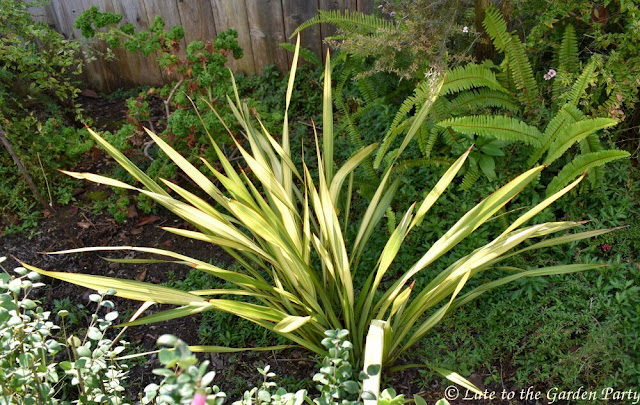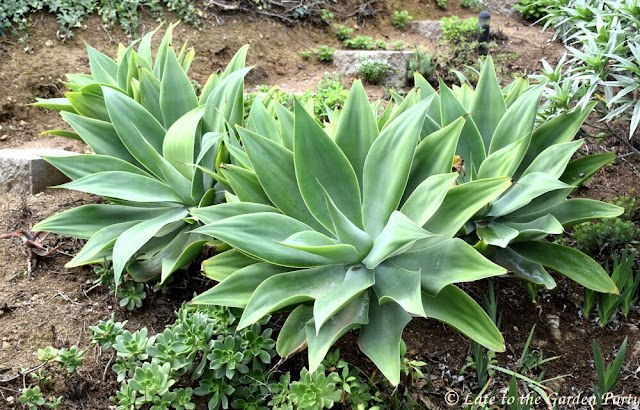Although my garden is already showing signs of gearing up for spring's floral explosion, many of my foliage plants are looking so good they warrant some attention. December's heavier-than-usual rainfall left them spanking clean and well hydrated. This post focuses on a variety of drought-tolerant plants, many but not all of which are succulents.
The south-side garden has become one of my favorite areas, partly because it looks good in every season.
| Image may be NSFW. Clik here to view.  |
| A few months ago, I filled in gaps in the in the area shown in the foreground here using succulent cuttings from elsewhere in the garden (various Aeoniums and an Agave attenuata 'Raea's Gold'). They're filling in nicely. |
| Image may be NSFW. Clik here to view.  |
| Euphorbia rigida planted itself between this Agave 'Blue Glow' and Agave 'Blue Flame' but I like how the color picks up that of both the Agaves and the Aeonium 'Sunburst' |
| Image may be NSFW. Clik here to view.  |
| Aeonium 'Zwartkop' looked terrible before the rains but now it's beautifully echoing the red edges of Agave 'Blue Glow'as it was intended to do |
| Image may be NSFW. Clik here to view.  |
| Agave mediopicta 'Alba', one of 3 given to me as pups years ago by Hoover Boo of Piece of Eden, is also doing a good job playing off the blue Agaves |
The moderate front-facing slope is often overlooked as it's partially hidden behind the hedge lining the street.
| Image may be NSFW. Clik here to view.  |
| Most of the succulents on this slope started small or as cuttings |
| Image may be NSFW. Clik here to view.  |
| Purchased as Agave celsii in 2017, this Agave is now classified as Agave 'Multicolor', a hybrid of A. mitis. I have 2 other smaller specimens here, one a gift from blogger Denise of A Growing Obsession. |
| Image may be NSFW. Clik here to view.  |
| Aloe labworana could benefit from being moved or at least divided |
| Image may be NSFW. Clik here to view.  |
| So far, hybrid Aloe vanbalenii x striata hasn't bloomed but it doesn't matter - I love its form |
| Image may be NSFW. Clik here to view.  |
| These Agave desmettiana were planted here as pups of my first specimen, which bloomed out years ago. With so many Aeonium arboreum bearing bloom spikes this year, I have the opportunity to clear some of the space around them as the blooming rosettes die back. |
The plants that grabbed my attention in the back garden aren't succulents.
| Image may be NSFW. Clik here to view.  |
| I love the silvery tones of Echium webbii even more than the variegated foliage of Echium candicans 'Star of Madeira' |
| Image may be NSFW. Clik here to view.  |
| I pruned Hebe 'Purple Shamrock' in November and it's come back well. I probably should have pruned it even harder. |
| Image may be NSFW. Clik here to view.  |
| I hard-pruned Salvia canariensis in the fall. I like it as much without flowers as with them. |
| Image may be NSFW. Clik here to view.  |
| Every year when I prune this Melianthus major (usually earlier than recommended), I fear I've gone too far but it always bounces back. I admire the leaves that look as though they were cut with pinking shears. |
When we moved in, I had very low expectations for the north-side garden but it's become another of my favorite areas.
| Image may be NSFW. Clik here to view.  |
| I had to search my records to give this Agave a name. It's Agave capensis, purchased as a tiny plant through The Huntington Garden's International Succulent Introductions (ISI) program in October 2015. The species is often a messy clumper but this is a solitary specimen. |
| Image may be NSFW. Clik here to view.  |
| I purchased this Phormium tenax 'Yellow Wave' in 2011. It's showing off to better advantage since I pruned the Correa 'Pink Eyre' in front of it. (Note: This is NOT the Phormium shown next to Agave capensis in the earlier photo. That one is P. tenax 'Apricot Queen', also purchased in 2011.) |
| Image may be NSFW. Clik here to view.  |
| While pruning and cleaning up the north-side area this week, I uncovered 2 Agave pups. The one on the left was growing in the gravel walkway, hidden underneath a mass of Aeonium 'Kiwi', and I haven't a clue what it is as it doesn't look like any of its neighbors. The pup on the right is Agave funkiana 'Blue Haze'. |
I had very low expectations of the back slope when we moved in and I still do. This area frustrates me more than any other. Its steep slope, the inability get heavy equipment in there because of the way it's sandwiched between two neighboring properties, and our deepening drought have all impacted my options for this area. The presence of fire ants has also dissuaded me from doing much there during the warm months when the ants are most active. That said, the area has some positive attributes.
| Image may be NSFW. Clik here to view.  |
| As I recall, all the Agave attenuata shown here were transplanted as pups of the specimen I inherited with the garden. Their success relative to other plants I've introduced in this area of the slope has led me to believe that I should plant the entire area in succulents. |
| Image may be NSFW. Clik here to view.  |
| My Drimia maritima (aka giant sea squill) didn't bloom last year but their foliage is a bigger attraction than their flowers for me anyway. The plants die back completely in summer, reappearing once it rains again in the fall/winter. Shown here are 2 views of the largest specimen, planted as a bulb in 2019. |
| Image may be NSFW. Clik here to view.  |
| I added 4 more of the gigantic bulbs in 2020, all of which you can see in this photo. They sit across from the lemon tree, very close to the property line. The ivy that creeps over from the neighbor's property is another headache associated with the back slope. |
January is proving to be as dry as earlier forecasts projected, at least in my area. We got two hundredths of an inch of rain last Saturday and that's been it for the month with no significant chance of rain on the horizon in the the next ten days. Hopefully, February, traditionally the rainiest month of our short rainy season, will be better.
All material © 2012-2022 by Kris Peterson for Late to the Garden Party